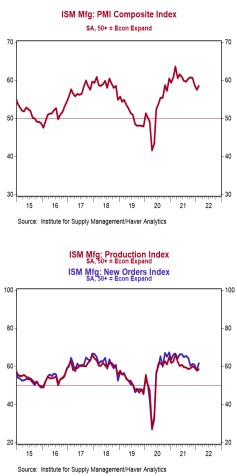- The ISM Manufacturing Index increased to 58.6 in February, beating the consensus expected 58.0. (Levels higher than 50 signal expansion; levels below 50 signal contraction.)
- The major measures of activity were mostly higher in February, and all stand above 50, signaling growth. The production index rose to 58.5 from 57.8 in February, while the new orders index increased to 61.7 from 57.9. The employment index fell to 52.9 from 54.5, and the supplier deliveries index rose to 66.1 from 64.6 in February.
- The prices paid index declined slightly to 75.6 in February from 76.1 in January.
Implications:
The manufacturing sector continued to expand in February, and at a slightly faster pace, with sixteen of eighteen industries reporting growth. The two most forward-looking indices, new orders and production, posted gains in February and remain well in expansion territory. Respondent comments in February highlighted strong demand from customers, but also ongoing difficulties related to shortages of key inputs and transportation services. These issues have all come together to keep manufacturing activity from rising quickly enough to meet the explosion of demand as the US economy reopens. However, there has been recent progress on several fronts. For example, despite the small increase in February the supplier deliveries index is well below its recent high back in May 2021, signaling that supply-chain issues are easing. However, delays are far from over, with fifteen of eighteen industries reporting waiting longer for inputs. This, in turn, has resulted in long lead times for the clients of US factories, who continued to see their inventories shrink in February. The good news is that the rate at which those inventories are shrinking has begun to slow. Staffing troubles also remain a persistent issue when it comes to ramping up production, with the employment index posting its first decline in six months in February. Manufacturing is one of the worst-hit sectors in the ongoing labor shortage, with job openings twice what they were pre-pandemic. Finally, the highest reading of any index in February continued to come from the prices index, though it fell slightly to 75.6 in February from 76.1 in January. While this is considerably slower than the peak reading of 92.1 in June, it still signals rapid increases in prices from a historical perspective. Our view continues to be that inflation remains a problem but won't be quite as rapid for all of 2022 as it was last year, though the recent invasion of Ukraine is likely to put upward pressure on prices over the next several months. In other news this morning, construction spending rose 1.3% in January (+2.3% including revisions to prior months), with large increases in home building and manufacturing projects more than offsetting declines in water supply and commercial construction.





